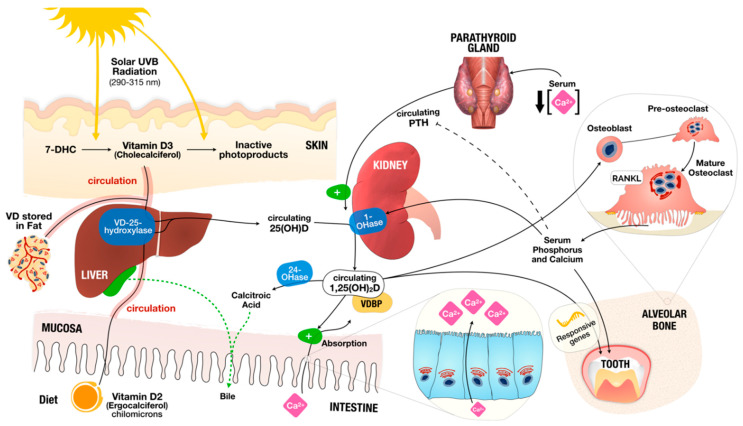Figure 1.
Vitamin D and Calcium, Phosphorus and Bone Metabolism. Vitamin D is obtained mostly from sunlight exposure (Vitamin D3) and from diet (Vitamin D2). In contact to solar ultraviolet B (UVB) radiation, 7-dehydrocholesterol (7-DHC) present in the skin is immediately converted to vitamin D3 in a heat-dependent process. Excessive sunlight exposure can destroy Vitamin D3 and convert it into inactive photoproducts. Vitamin D2 from diet is absorbed in the form of chylomicrons when they spread into the bloodstream as Vitamin D (encompassing Vitamin D2 or D3). Vitamin D in the circulation is bound to the vitamin D–binding protein (VDBP), which transports it to the liver. There, Vitamin D is converted by vitamin D-25-hydroxylase (VD-25-hydroxylase) to 25-hydroxyvitamin D (25(OH)D) (used as standard surrogate to determine vitamin D status). Then, 25(OH)D circulates, reaching the kidneys where it is activated by 25-hydroxyvitamin D-1αhydroxylase (1-OHase) to 1,25-dihydroxyvitamin D (1,25(OH)2D). Serum phosphorus or calcium can impact renal production of 1,25(OH)2D. 1,25(OH)2D promotes negative feedback of parathyroid hormone (PTH) by the parathyroid glands. 1,25(OH)2D increases the expression of 25-hydroxyvitamin D-24-hydroxylase (24-OHase), upholding its excretion in the bile. 1,25(OH)2D is recognized in the osteoblasts, causing the induction of mature osteoclast through expression of the receptor activator of nuclear factor-κB ligand (RANKL). Mature osteoclasts remove calcium and phosphorus from the bone, maintaining the serum levels of calcium and phosphorus.

